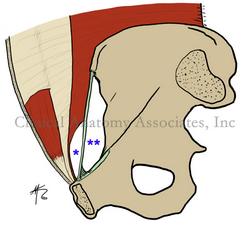The term [myopectineal orifice] was coined originally by Dr. Henri Fruchaud, and refers to a "distinct area of weakness in the pelvic region". The term [myopectineal] arises from two root terms which are combined. The root term [-my-] means "muscle" and the term [-pect-] means "comb"or "pectinate". The word [pectineal] in this case refers to the pelvic bone area of origin of the pectinate muscle of the thigh.
Fruchaud postulated that the anterior abdominal wall has an area that is inherently weak, and that this area is genetically determined. As such, hernias are part of human nature, or as he stated, "a healthy man is, unknown to himself, a hernia bearer".
The myopectineal orifice, or MPO, is bound superiorly by the arching fibers of the transversus abdominis and internal oblique muscles, and inferiorly by the pectineal line.
The MPO is then composed by two regions separated by the inguinal ligament; the suprainguinal region, marked by one asterisk and site for direct and indirect inguinal hernias, and a small subsegment of the subinguinal region, (marked by two asterisks), site for femoral hernias.
In the accompanying sketch, the subinguinal region looks large, but this area is closed off by muscles, arteries, veins, and nerves, leaving only a small area of weakness (the femoral ring) where femoral hernias can arise.
Fruchaud advanced the separate concepts of inguinal hernias and femoral hernias and provided a new (for the time) concept of the repair of these hernias. Today, with laparoscopic herniorrhaphy, a surgeon attempts to repair the weak MPO instead of only the herniated locus.
Image property of:CAA.Inc.. Artist:David M. Klein
Source:
"Henri Fruchaud (1894–1960): A man of bravery, an anatomist a surgeon" Stoppa,R and Wantz,G. Hernia 1998,Vol 2,(1) 45 - 47
Clinical anatomy of the inguinofemoral hernias, as well as abdominal and perineal hernias are some of the lecture topics developed and delivered to the medical devices industry by Clinical Anatomy Associates, Inc. For more information Contact Us.




